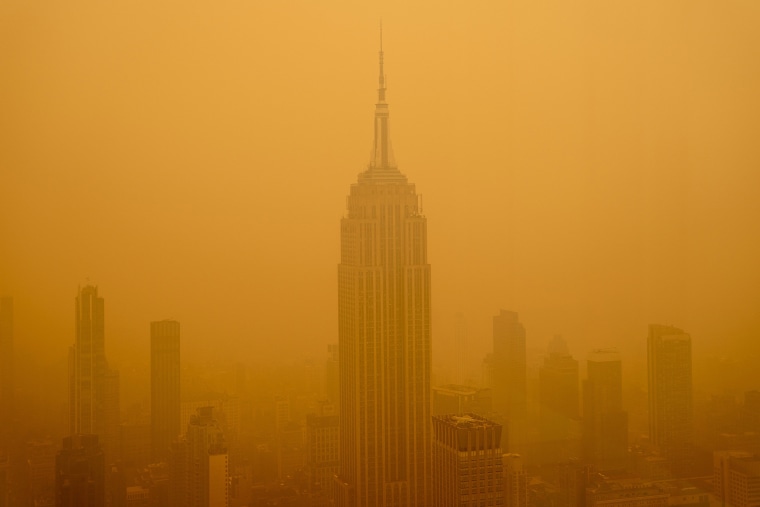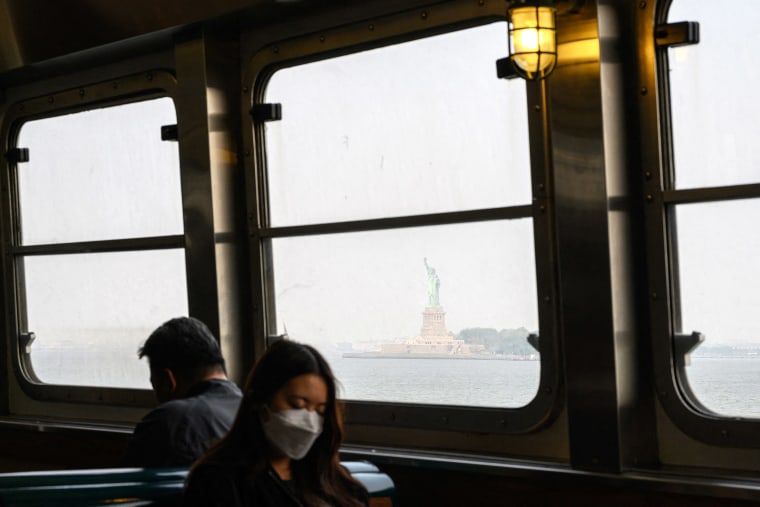After a day of orange haze that cast a pall over New York City, obscuring some of the country’s best-known landmarks with smoke from Canadian wildfires, New Yorkers and others were in store for another day of bad air Thursday.
The smoke in major metro areas, including Boston, Philadelphia and Washington, D.C., was expected to continue through the day and cause unhealthy air for all groups, the National Weather Service said.
Mayor Eric Adams called the situation unprecedented, with air quality advisories in place for all five boroughs of the city of more than 8 million people.

“Yesterday, New Yorkers saw and smelled something that has never impacted us on this scale before,” he said at a briefing Wednesday. “From the gloom over Yankee Stadium to the smoky haze obscuring our skyline, we could see it, we could smell it and we felt it. And it was alarming and concerning.”
The smoke shrouded New York City's glittering skyline Tuesday into Wednesday, accompanied by the smell of burned ash.
Follow live coverage of U.S. air quality conditions and Canada’s wildfires
Katie Schaller, who works in Hoboken, New Jersey, but lives in Brooklyn, could tell something was off on her commute home Tuesday night.
"It is really strange," she said. "It does feel like we’re in California or somewhere that had wildfires."
There are wildfires burning in the U.S., but the smoke that is affecting millions of people in the country is drifting south from Canada, where more than 400 wildfires were burning Wednesday, according to officials there.
The New York State Department of Environmental Conservation has issued an air quality health advisory through Thursday.
“We expect this to be a multiple-day event, so we expect that advisory to remain in place for the next few days. Again, it is notoriously difficult to forecast smoke in these types of events,” Emergency Management Commissioner Zachary Iscol said Wednesday.
The city’s air quality sank to the worst in the world around 9 p.m. Tuesday, according to a ranking by IQAir, a Swiss site that monitors air quality in several major cities around the globe — and it remained in the No. 1 spot Wednesday.

Adams said the air quality index hit 218 at 10 p.m. Tuesday — “a very unhealthy level” — which “sent shock waves throughout the county and region.”
Iscol said that at this time of the year, it’s “very normal” to have an AQI of more than 100 but that it’s concerning when the rating surpasses a threshold of 150.
By Wednesday, Brooklyn had recorded 413, and Queens wasn’t far behind at 407, New York Gov. Kathy Hochul said at a news conference.
She said she considered the situation “a health and environmental crisis” and urged New Yorkers to limit their time outdoors.
Nancy Liang, who was wearing a mask as a precaution in Hoboken, said Wednesday: "The sun was orange when I woke up today. I didn’t want to breathe in the air like that.”
Adams urged New Yorkers to take precautions and said the city recommends that all vulnerable people stay indoors, limit outdoor time, close windows and doors and use air purifiers.
“If you’re older or have heart or breathing problems, you should remain inside or wear a mask,” he said.
While New York City students were in school Wednesday, all outside events were canceled. Thursday is a regularly scheduled no-attendance staff day.
According to AirNow.gov, the website of the Environmental Protection Agency, the higher the AQI, the greater the level of air pollution and the greater the health concern. AQI at or below 100 is considered satisfactory, but when it is above 100, air quality is considered unhealthy.
At 150 to 200, the air quality is considered to have possible health effects for sensitive groups.
The weather service said Wednesday that winds could shift more easterly after Thursday, pushing smoke farther west into the interior Northeast and the Ohio Valley on Friday.
Over the weekend, a stalled low pressure system near Maine is likely to continue to steer smoke from Quebec's wildfires into the northeastern U.S., the agency's New York City office said.
The three major airports that serve the New York City region — LaGuardia, JFK and Newark Liberty— all reported delays and other possible disruptions due to conditions Wednesday, including low visibility.
New York's state government announced a plan to distribute 1 million free N95 masks, including 400,000 to be handed out at public transportation and state-owned locations in the New York City area.
New York City Health Commissione Dr. Ashwin Vasan said Wednesday that, so far, there hadn't been an uptick in emergency room visits due to complications from the air quality event.
“That could change, and we’re monitoring that closely,” he said.
